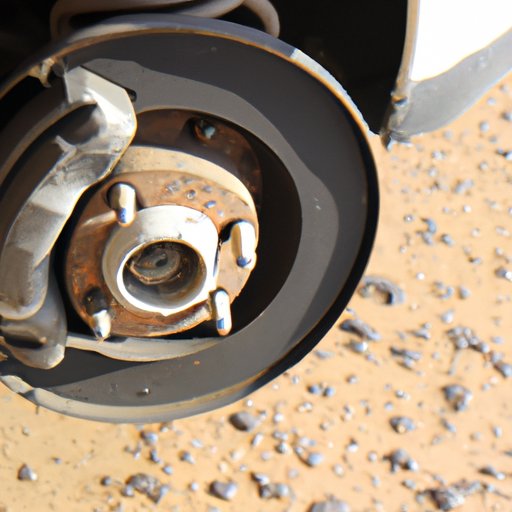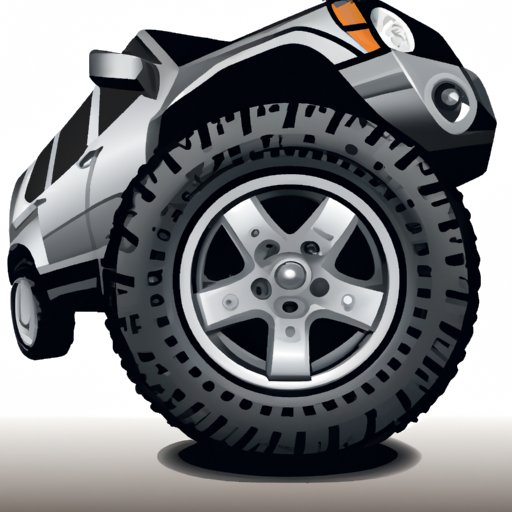Introduction
All wheel drive (AWD) is a type of vehicle drivetrain that sends power to all four wheels instead of just two. It’s designed to improve traction, stability, and control in difficult terrain or weather conditions, as well as providing better off-road capabilities and faster acceleration. In this article, we’ll explain what all wheel drive is, how it works, and the pros and cons of owning an AWD vehicle.
Explaining All Wheel Drive in Layman’s Terms
An all wheel drive system is made up of several components. At its most basic level, the system consists of a transmission, driveshaft, differential, axles, and four wheels. The transmission sends power from the engine to the driveshaft, which then sends the power to the differential. The differential then distributes the power to the axles, which turn the wheels. All four wheels receive power at the same time, so they all move simultaneously.
In addition to these mechanical components, all wheel drive vehicles also have computerized systems that monitor the speed and torque of each wheel. These systems can adjust the amount of power sent to each wheel depending on the driving conditions. For example, if one wheel begins to slip due to poor road conditions, the system will send more power to the other three wheels to help maintain traction.
Comprehensive Guide to All Wheel Drive Systems
There are several different types of all wheel drive systems, each with its own set of advantages and disadvantages. Full-time AWD systems are the most common, and they provide power to all four wheels at all times. This type of system is great for off-roading and other activities that require increased traction and stability. Part-time AWD systems are also available, but they only provide power to all four wheels when extra traction is needed. This type of system is often used in SUVs and other vehicles that need occasional off-road capability.
On-demand AWD systems are becoming increasingly popular, as they provide the benefits of full-time AWD without sacrificing fuel economy. On-demand systems only send power to all four wheels when extra traction is needed, such as when accelerating from a stop or cornering. They can also be used to improve stability in slippery conditions, such as rain or snow.
How All Wheel Drive Enhances Performance and Safety
All wheel drive systems offer several advantages over traditional two-wheel drive systems. One of the most significant benefits is improved traction and stability. By sending power to all four wheels, AWD vehicles can maintain grip even under difficult conditions. This increases safety, as the driver has more control over the vehicle.
All wheel drive systems also increase fuel efficiency by reducing the amount of power lost in the transmission and differential. This makes them ideal for vehicles that are driven in wet or icy conditions, as they can reduce the amount of fuel needed to maintain traction.
Finally, AWD systems can also enhance control in difficult terrain or weather conditions. By providing power to all four wheels, they can reduce the amount of slipping and sliding that occurs when driving on slippery surfaces. This can make it easier to navigate steep hills, deep snow, and other challenging terrain.

The Benefits of All Wheel Drive Systems
As mentioned above, all wheel drive systems offer several advantages over traditional two-wheel drive systems. Improved traction and stability are the most obvious benefits, but there are also some other benefits to consider. First, AWD vehicles typically have faster acceleration than two-wheel drive vehicles. This is because the power is distributed to all four wheels instead of just two, which reduces the amount of time it takes to get up to speed.
Additionally, all wheel drive systems can also improve braking performance. By distributing power to all four wheels, the vehicle can maintain greater control during hard braking, which can help reduce stopping distances. This is especially beneficial in wet or icy conditions, where two-wheel drive vehicles may struggle to maintain traction.

Understanding the Technical Aspects of All Wheel Drive
To understand how all wheel drive systems work, it’s important to first understand the mechanical components involved. The main components of an AWD system include a transmission, driveshaft, differential, axles, and four wheels. The transmission sends power from the engine to the driveshaft, which then sends the power to the differential. The differential then distributes the power to the axles, which turn the wheels. All four wheels receive power at the same time, so they all move simultaneously.
In addition to the mechanical components, all wheel drive systems also use computerized systems to monitor the speed and torque of each wheel. These systems can adjust the amount of power sent to each wheel depending on the driving conditions. This allows the system to maximize traction and stability, as well as allowing for increased fuel efficiency.

The Pros and Cons of All Wheel Drive Vehicles
All wheel drive vehicles offer several advantages over traditional two-wheel drive vehicles. They provide improved traction and stability, as well as better off-road capabilities and faster acceleration. They also offer increased control in difficult terrain or weather conditions, as well as improved fuel efficiency.
However, there are some drawbacks to consider. All wheel drive systems can be heavier and more expensive than two-wheel drive systems, which can lead to decreased fuel efficiency and higher maintenance costs. Additionally, they can be less responsive in dry conditions, as the extra weight of the system can make the vehicle feel sluggish.
Conclusion
All wheel drive systems offer several advantages over traditional two-wheel drive systems, including improved traction and stability, better off-road capabilities, faster acceleration, and increased control in difficult terrain or weather conditions. However, they can also be more expensive and require more maintenance. Understanding how all wheel drive works can help you decide whether or not it’s the right choice for your vehicle.
In conclusion, all wheel drive systems provide improved traction, stability, and control, but there are pros and cons to consider. This guide provides an overview of all wheel drive systems, their advantages and disadvantages, and how they can enhance performance and safety.
(Note: Is this article not meeting your expectations? Do you have knowledge or insights to share? Unlock new opportunities and expand your reach by joining our authors team. Click Registration to join us and share your expertise with our readers.)
